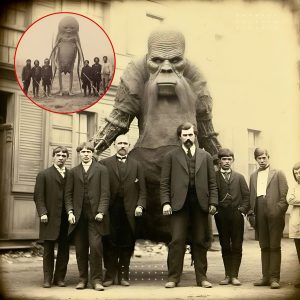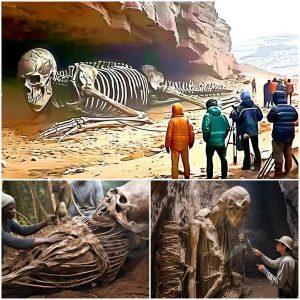In the 1890s, Hallsands was a small fishing village in South Devon, home to 160 people and 37 houses, protected by a sand and shingle beach.

However, the village became vulnerable to the tides, and in 1917, a huge storm caused significant damage, leading to its abandonment.
The early history of Hallsands remains largely a mystery, though records show a chapel standing there as early as 1506.
Situated near a cave called Poke Hole, it’s likely the village wasn’t settled before the 1600s.

Hallsands expanded throughout the 18th and 19th centuries, and by 1891, it was home to 37 houses, a natural spring, and the London Inn.
With a population of 159, most villagers earned their livelihood from fishing, particularly crab fishing on the Skerries Bank nearby.
Life was tough for the small community, as fishing alone couldn’t sustain them year-round.
During the winter months and bad weather, many fishermen turned to farming the steep cliffside plots to make ends meet.
Most men in the village had other trades—tailors, carpenters, and blacksmiths—to bring in additional income, making the village largely self-sufficient.
Fishing, however, remained the heart of Hallsands, just like other villages along Start Bay.

When the shoals arrived, everyone pitched in.
A lookout kept watch for the telltale oily sheen on the water’s surface, a sign that mackerel or pilchards were nearby.
At his call of “Aye boat,” he’d wave his bowler hat—a signal the fish had arrived.
When the nets needed hauling, the whole village, including women and children, would rush to the beach to help drag in the big seine nets, securing a catch large enough to feed the community.
In the 1890s, under a plan proposed by Sir John Jackson, it was decided to expand the naval dockyard at Keyham near Plymouth.
Dredging off the coast of Hallsands began to supply sand and gravel for the project, with up to 1,600 tons being removed daily.

As the beach level began to drop, locals grew alarmed. In response to villagers’ protests, the Board of Trade initiated a local inquiry.
Despite concerns about destabilising the beach, the inquiry concluded that the dredging posed no serious risk, and the work continued.
By 1900, the beach level had noticeably decreased. Autumn storms that year damaged part of the sea wall.
In November, villagers petitioned their Member of Parliament, reporting damage to their homes, while Kingsbridge Rural District Council raised concerns about damage to the road in early 1901.
In September, a new Board of Trade inspector warned that further storms could cause significant harm and recommended halting dredging.
On January 8, 1902, the dredging licence was revoked.

Although the beach began to recover during 1902, winter storms brought renewed damage.
The final storm of 1917
On January 26, 1917, powerful easterly gales combined with unusually high tides to overwhelm Hallsands’ defences, leaving only one house habitable by the year’s end.
The fishermen, expecting worsening gales, storms and a high tide, hauled the boats high up in to the village street and battened them down.
The children were evacuated to the Mildmay Cottages.
At 8pm spring tides brought huge waves which crashed into the houses at roof height and destroyed the buildings behind the sea walls from above.
The houses built on the empty chasms in the ledge collapsed and those on the rocks were battered by wind, waves and stones.

The villagers feared for their lives.
By midnight, four houses were totally demolished and none survived intact.
Amazingly, all 79 villagers survived and scrambled to safety during a lull in the storm at low tide.
Dawn on 27th January revealed a devastating picture, the sea was strewn with timber and broken furniture.
The sea walls had held, otherwise many more houses, and possibly lives, would have been lost.
It was likely that the next high tide would destroy all that remained so with the wind still raging, villagers worked to salvage what they could.

On 28th January 1917, with the next high tide, the walls broke and the village was destroyed.
Only one house remained in any way habitable, the highest in the village, that of the Prettyjohn family.
The Kingsbridge Gazette that day led with the headline ‘The beach went to Devonport and the cottages went to the sea’.
Various offers of compensation were made and some new houses were built.
The story continued to be uncovered as recently as 2002 when a local journalist uncovered reports at Kew record office from the enquiry.
It took the villagers seven years to secure compensation for their losses.

A 1960 Pathe News newsreel reported that the village’s last resident was Mrs. Elizabeth Prettejohn.
Today, the old village site at South Hallsands is closed to the public, though South Hams District Council has constructed a viewing platform accessible via the path below Prospect House Apartments.
While two houses remained intact and were used as holiday homes, a 200-tonne landslide in May 2012 affected the access road, viewing platform, and houses, resulting in evacuations and the area being cordoned off.
North Hallsands, also known as “Greenstraight,” is the only remaining beach.
The beach below the old village has vanished due to dredging and repeated storms.
In 2016, storms washed away the beach at North Hallsands, exposing a peat underlay containing remnants of a petrified forest.

However, this is part of a natural cycle, where the shingle is periodically removed by sea currents and then gradually returned over time.
Since 2002, South Hams District Council has maintained a no-intervention policy, with no plans to restore sea defences or protect the few remaining houses at risk.





